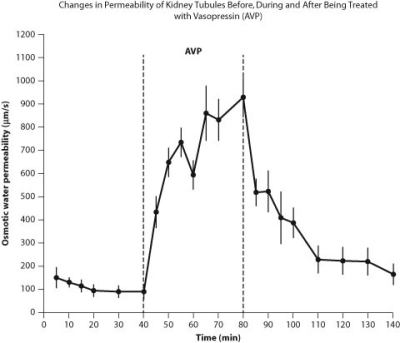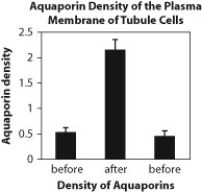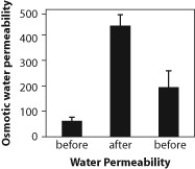Water movement is important in urine formation in the kidneys. Urine is formed when the blood is filtered by the kidneys into kidney tubules. Three figures are presented here that relate to how the kidney tubules respond to the administration of the hormone vasopressin. The direction that water flows in these figures is from the kidney tubules back into the blood.
 Figure A. Changes in permeability of tubules in the kidney in response to the hormone vasopressin (AVP) , which aids in osmoregulation.
Figure A. Changes in permeability of tubules in the kidney in response to the hormone vasopressin (AVP) , which aids in osmoregulation.
 Figure B. Density of aquaporins in kidney tubule cells before, during, and after administration of vasopressin.
Figure B. Density of aquaporins in kidney tubule cells before, during, and after administration of vasopressin.
 Figure C. Permeability of tissues to water before, during, and after administration of vasopressin.
Figure C. Permeability of tissues to water before, during, and after administration of vasopressin.
-Using the data from the graphs and what you know about membranes and metabolic pathways, predict which of the following is the likely reason why actions of aquaporins in a membrane can change so rapidly.
Definitions:
Normal Distribution
A probability distribution that is symmetric about the mean, showing that data near the mean are more frequent in occurrence than data far from the mean.
Security Returns
The gains or losses on an investment over a specific period, including dividends, interest, and capital gains, usually expressed as a percentage.
Standard Deviation
A statistical measure that quantifies the variation or dispersion of a set of data points or investment returns.
Arithmetic Return
The simple average of a series of periodic returns of an investment.
Q1: In a certain ecosystem, field mice are
Q5: If a freely falling object were somehow
Q7: The certainty of paternity is greatest in
Q14: Which plant response is affected by photoperiod?<br>A)
Q18: Which of the following statements about internal
Q28: According to the accompanying figure, which of
Q35: Consider drops of water that leak at
Q37: A student wanted to plant an avocado
Q54: Rising concentrations of carbon dioxide (CO<sub>2</sub>) in
Q82: NADH pills can be purchased over the